At some point, in one of the numerous checkpoints one has to pass through travelling the highway (smile, show some ID, say where you’ve been and where you’re going to), a fully armed soldier went into our bus carrying a laminated roster of wanted terrorists, their grainy photos checked against our faces. One is immediately confronted with a mixture of fear, self-confidence, and doubt—confident that you did not resemble any one of those in the photos, fear of being taken a second look at nonetheless, and finally, doubt at the effectivity of such a method in catching terrorists. But it is martial law country, and going by the logic of military rule, anyone who registers doubt or fear must have something to hide. So even if I had nothing to hide except for my thoughts, I suppressed them and put on my most innocent face on as our vehicle was cleared with a single wave.
I went with a National Interfaith and Humanitarian Mission (NIHM) that traveled to Maguindanao upon word that hundreds of Moro families have evacuated from their villages due to intensified military operations that started on the first week of June, shortly after the declaration of martial law. While much of the conflict has occurred in Marawi City, martial law is enforced in the whole of Mindanao—a vast group of islands home to millions of people, Muslim, Christian, and Lumad alike. And although there is officially a single reason for the declaration of martial law—the attack of the ISIS-inspired Maute group—unofficially, martial law is being touted by the government as a hardline approach to crush not just the Maute group, not just terrorism, but also, to end all forms of conflicts in the region, “once and for all,” according to President Duterte himself.
Unfortunately, conflicts in Mindanao are as non-homogenous as the religion and ethnicities, language and sensibilities, history and struggles of its people. Maguindanao’s history of conflict, for instance, is particularly notorious—from the Ampatuan warlords’ massacre of journalists in 2009, to the botched anti-terrorist operations that led to the killing of 44 SAF troopers in 2015. The province is also a paragon of inequality, where gaudy mansions of politicians are alongside shanties built on swamps. Two armed Moro resistance groups operate in the province—the Moro Islamic Liberation Front (MILF) and the Bangsamoro Islamic Freedom Fighters (BIFF). The former is awaiting results of a peace deal, while the latter is pushing forward with the Bangsamoro struggle for self-determination. However, the BIFF broke into two factions last year—fighters led by Commander Kagi Karialan, has distanced itself from another faction, led by Commander Bungos, which has allegedly subscribed to the ideology of ISIS.

Two armored personnel carriers on standby at the village hall of Madia, Datu Saudi Ampatuan, Maguindanao. (Photo by Hiyasmin Bisoy/ Mayday Multimedia)
Maguindanao is a militarized zone even without martial law; martial law has made it even more so. Every few hundred meters, soldiers stand clustered in checkpoints or peering from makeshift barracks. Two armored personnel carriers are parked side by side in front of a barangay hall, almost eclipsing the entire structure. Perhaps this kind of military presence is what those in the cities refer to as the kind that keeps them “safe.” But I was soon to find out that it means the exact opposite for thousands of Muslims living in the barrios.
Shortly beyond the cornfields of Brgy. Tukanalipao, site of the infamous Mamasapano encounter, lies a bustling public market. Pesticides, home implements, school supplies, and Muslim attire are being sold under tarpaulins bearing the sign of the UN High Commission on Refugees. Despite the veneer of normalcy, it is obviously a place accustomed to war. A family traversing the road had their personal belongings and a carabao in tow. They were among the evacuees who were staying in a madrassa or Islamic school in Brgy. Libutan.
When we arrived, many of them were already in the process of packing up to go back to check on their homes and fields. Initial reports they’ve received have not been good. Houses have been burnt by mortar and air bombs that started falling the first week of June. Rice fields have turned murky brown, or have virtually been destroyed for the entire planting season.
One evacuee, Mali Itantoli of Brgy. Tina, counted the bombs that flew over their heads as they left their village and ran, as well as those that they continued hearing even in the safety of the lowlands. He swore that it reached 200. Another evacuee, Cosain Hadji, a disabled person who had to be carried on his nephew’s back, described how the ground shook, “as if in an earthquake,” as the bombs fell all around.
The Muslims were in the middle of Ramadhan, so fasting left them with little energy to endure the long downward trek, made all the more perilous by intense rainfall that made impossible slopes of slippery mud. Respite, once they finally reached the evacuation center, was temporary, for no help came. All eyes were on Marawi City. Only a local politician gave relief goods once, and they have been there for two weeks. For five families, a couple of kilos of rice, a couple of cans of sardines, and five sachets of instant coffee. “We are asking even for just drinking water. Right now we are drinking from the deep well, so our children are getting sick,” cried Wahida Sumagka of Brgy. Bialong.
Around the madrassa were trees of wani mango—a distinct pulpy, strong-tasting mango whose smell is almost as pungent as durian. To visitors, they were sweet, refreshing treats, and they were offered to us in baskets. Little did we know that to the evacuees, they were already meals—in fact the only thing that they could feed their children.

Muslim evacuees have received no relief since the first week of June and have resorted to eating mangoes for meals. (Photo by Hiyasmin Bisoy/ Mayday Multimedia)
According to news reports, the clashes in Maguindanao were between the AFP and the BIFF, as well as “local ISIS groups.” It was difficult to look for a first-hand eyewitness of these ISIS-inspired groups, as most evacuees saw nothing, or only heard of it as rumours that have been passed around. Only one of them was actually able to say that he saw them with his own eyes—armed men who covered their faces, and wore black clothes and armbands with an insignia. “What do you think of these men?,” I asked Ting Alon of Brgy. Bialong. His candid answer was, “They caused us no harm, as they were just passing through.” What he was scared of, and what to him constituted harm, were the mortar bombs and air strikes that came after.
I was to get a taste of what he meant in Brgy. Dapiawan, Datu Saudi Ampatuan, an area where the BIFF is operating, and where hundreds of families have also evacuated due to mortar and air strikes. A few hundred meters into the plains, you could already see the vestiges of war—a chunk torn off a coconut tree trunk, a scorched hole in the ground, tracks in the mud that only an Army tank could leave behind. A resident of Brgy. Dapiawan, Sofia Abubakar, led us into her newly constructed house and showed us the holes left by bullets. Suddenly, nearby shots were fired. Sofia nervously smiled and said, “That’s nothing.” We were still walking through rice paddies when, aside from now intermittent sounds of gunfire, we heard an incoming aircraft. A bomb exploded in the nearby distance. It was time to get out.
Before leaving, we chanced upon the grief-stricken parents of 35-year-old Muslim farmer Jaynudin Alimudin of Brgy. Dapiawan. Alimudin was working on his rice field when a volley of shots felled him last June 8, according to his parents. They did not know who fired the shots that killed their son, a father of seven children. Worse, they do not ever believe that they can find out.
Determined to get to the bottom of the conflict, I interviewed by phone Abu Amir, spokesperson of Kagi Karialan, commander of the “moderate” BIFF faction. According to Amir, they received reports that armed men led by Abu Toraype—which, according to the military, heads a new terrorist group Dawlah Islamiyah (Islamic State) Maguindanao—went to two villages in Shariff Saydona last June 6. But when the group of Toraype left, the military diverted its attacks to BIFF-controlled areas in Brgy. Elian and Dapiawan in Datu Saudi Ampatuan, according to Amir. “The military knows very well that those are areas of responsibility of the BIFF. So when they arrived, the commanders took [it upon] themselves to confront the enemy,” he said.
I asked him point-blank, do you subscribe to ISIS? (The military claims they do.) He said, no. They do not aspire to an Islamic State “in the world,” but only aspire for “freedom” from colonizers in Mindanao. This freedom they are aspiring for, he said, is not only for the sake of the Bangsamoro, but for Christians and Lumad in Mindanao as well. So I asked, what do you think of the Maute Group and local groups who affiliate themselves to ISIS? “Our directives from the Koran prohibit the use of bombs in places populated with civilians. It also prohibits us from hurting the elderly, women, priests, teachers, and other civilians in the conduct of war,” Amir explained. He reiterated that the BIFF had nothing to do with what was going on in Marawi City—but that they would defend their own areas if the military attacked them. I pressed on about the BIFF faction that has allegedly pledged allegiance to ISIS, but he declined to comment, and said that he can only speak for their own faction.

Evacuees in Brgy. Libutan, Mamasapano, Maguindanao. (Photo by Hiyasmin Bisoy/ Mayday Multimedia)
Finally, I inquired, “What do you think of martial law?” He said, “We are not alarmed with martial law. Because the death of one mujahideen means that he can enter paradise. A million thanks to the president of the Philippines as he opened the door to enter paradise.”
His answer only confirmed to me what I already instinctively knew: that martial law has paved the way not to end, but to exacerbate, conflict in Mindanao. Even without martial law, indiscriminate aerial and heavy artillery bombings, as well as abuses of ground troops—such as hamletting, looting, arbitrary arrests, torture and interrogation—are common fare in rural communities. As long as the Armed Forces of the Philippines uses these same techniques in the name of chasing terrorists, soldiers can be hailed as heroes—but they will not get the support of the people on the ground, where it really, really matters.
All in all, the NIHM documented, in just one day and with a limited team of volunteers, one extra-judicial killing, 36 cases of harassment and intimidation, 24 cases of destruction of property due to indiscriminate aerial bombing and mortar shelling, 22 cases of coercion, 12 cases of looting, and 12 cases of violation of domicile. Except for the killing of Alimudin, the victims clearly identified the perpetrators as members of the Philippine Army. This is just the three weeks since martial law; in two municipalities out of hundreds in the region.
So what happens, then, to the fight against terrorism if the main force fighting terrorists is also sowing its own brand of terror? If, in the war against terrorism, war too is waged against civilians, who automatically lose their presumption of innocence, who automatically lose their right not to have bombs rained down upon them just because a group of presumed terrorists happened to pass by their houses? There are no easy answers.
But one thing is for sure, according to Cosain Naga, spokesperson of Kawagib Human Rights Alliance: majority of Moro communities in Maguindanao do not condone terrorism. Naga, a Muslim leader, joined the NIHM and talked to the villagers. “It seems that the people themselves are driving these ISIS [supporters] away from their communities, telling them to ‘not wreck havoc’ in their community. That’s why this commander Abu Toraype was told to go back to his community in Brgy. Pusau. So he was forced to go back to Brgy. Pusau, but then Brgy. Pusau was also bombed. What I’m trying to say is that the people themselves do not like ISIS and if the people are united against ISIS, they will never win. But the sad thing is, the military is using the presence of ‘ISIS’ as an excuse to conduct massive operations that mostly target civilians,” he said.

Children have stopped schooling because of bombings in Moro communities. (Photo by Hiyasmin Bisoy/ Mayday Multimedia)
Naga is of the belief that the ISIS is created by the US government’s Central Intelligence Agency. This, he said, is the reason why it can easily penetrate or infiltrate armed groups, and why local ISIS-affiliated groups can easily evade the military. He called on the Bangsamoro leaders, especially the ulama or Muslim scholars, to fight terrorism. “The Maute-Abu Sayyaf group is destroying the image, the purpose of the struggle of the Bangsamoro people with their acts of terror. The way we see it, the entry and formation of the Maute group, of ISIS, was done to destroy the legitimate struggle of the Bangsamoro,” he explained.
In a makeshift hut in Brgy. Libutan, a woman devoutly clings to her copy of the Koran as she sits on a hammock where she will sleep for the night. Like all other evacuees, she is hungry, and not just because she is fasting. “We have no livelihood here. You have to pay for every single thing you consume. I wish that the bombs would stop,” she said, her anger showing through her eyes. Dressed in a black niqab, her eyes were the only part of her face that was visible to me. But perhaps I have seen enough to understand that for our Muslim brothers and sisters in Mindanao, peace is not coming anytime soon.

![At some point, in one of the numerous checkpoints one has to pass through travelling the highway (smile, show some ID, say where you’ve been and where you’re going to), a fully armed soldier went into our bus carrying a laminated roster of wanted terrorists, their grainy photos checked against our faces. One is immediately […]](https://www.altermidya.net/wp-content/uploads/2017/06/muslims-martial-law-1-1000x600-1.jpg)

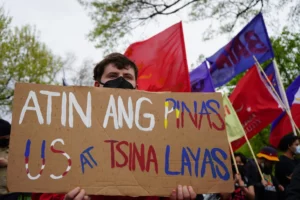
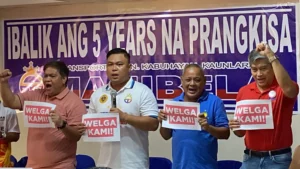
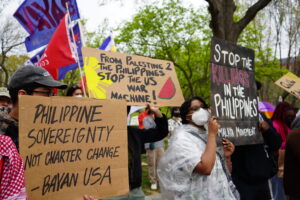

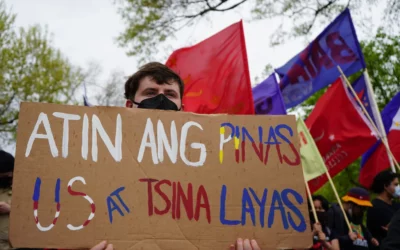
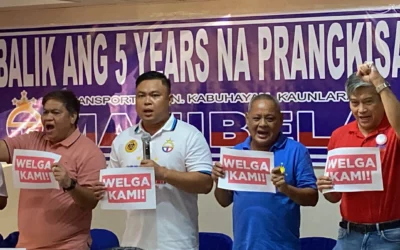
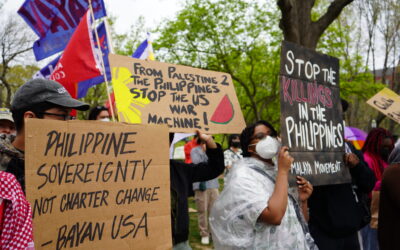
0 Comments